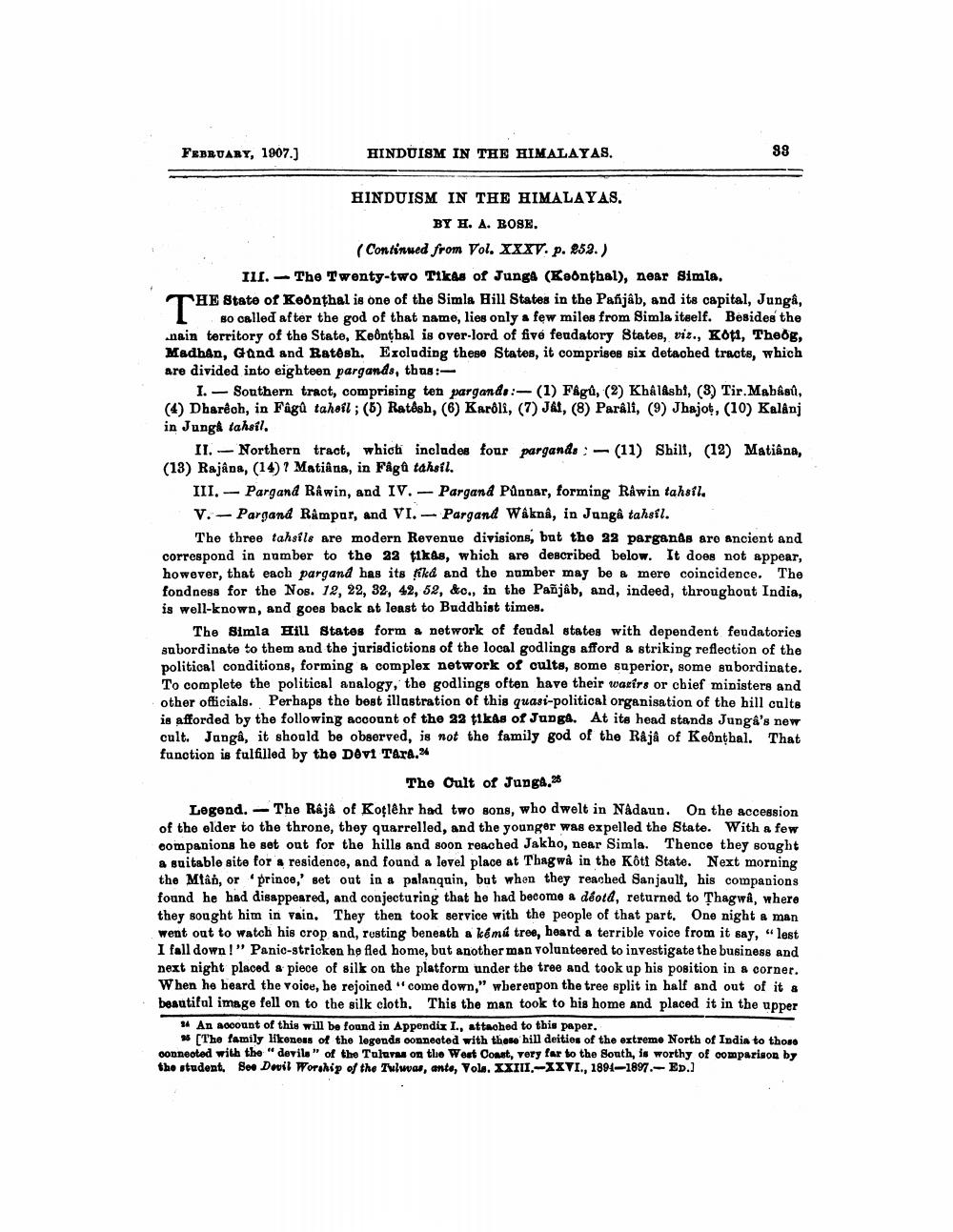________________
FEBRUARY, 1907.]
HINDUISM IN THE HIMALAYAS.
HINDUISM IN THE HIMALAYAS. BY H. A. BOSE.
(Continued from Vol. XXXV. p. 252.)
III.
The Twenty-two Tikas of Junga (Keonthal), near Simla. HE State of Keonthal is one of the Simla Hill States in the Pañjâb, and its capital, Jungâ,
name, lies only a few
88
nain territory of the State, Keônṭhal is over-lord of five feudatory States, viz., Koti, Theog, Madhan, Gund and Ratesh. Excluding these States, it comprises six detached tracts, which are divided into eighteen pargands, thus:
I.
Southern tract, comprising ten pargands:- (1) Fâgû, (2) Khâlâshi, (3) Tir. Mabâsû, (4) Dharêch, in Fâgû tahsil; (5) Ratêsh, (6) Karôli, (7) Jai, (8) Parâli, (9) Jhajot, (10) Kalânj in Junga tahsil.
-
II. Northern tract, which includes four pargands (11) Shill, (12) Matiâna, (13) Rajâna, (14) 7 Matiâna, in Fâga tahsil.
III. Pargand Râwin, and IV. - Pargand Pûnnar, forming Råwin tahsil.
V.
Pargand Rampur, and VI.
Pargand Wâknâ, in Jungâ tahsil.
The three tahsils are modern Revenue divisions, but the 22 parganas are ancient and correspond in number to the 22 tikas, which are described below. It does not appear, however, that each pargand has its tkd and the number may be a mere coincidence. The fondness for the Nos. 12, 22, 32, 42, 52, &c., in the Pañjâb, and, indeed, throughout India, is well-known, and goes back at least to Buddhist times.
The Simla Hill States form a network of feudal states with dependent feudatories subordinate to them and the jurisdictions of the local godlings afford a striking reflection of the political conditions, forming a complex network of cults, some superior, some subordinate. To complete the political analogy, the godlings often have their wasirs or chief ministers and other officials. Perhaps the best illustration of this quasi-political organisation of the hill cults is afforded by the following account of the 22 tikas of Junga. At its head stands Junga's new cult. Jangs, it should be observed, is not the family god of the Raja of Keônṭhal. That function is fulfilled by the Devi Tara.
The Cult of Junga.25
Legend. The Raja of Kotlêhr had two sons, who dwelt in Nâdaun. On the accession of the elder to the throne, they quarrelled, and the younger was expelled the State. With a few companions he set out for the hills and soon reached Jakho, near Simla. Thence they sought a suitable site for a residence, and found a level place at Thagwa in the Kôti State. Next morning the Mtân, or prince,' set out in a palanquin, but when they reached Sanjaulf, his companions found he had disappeared, and conjecturing that he had become a déotd, returned to Thagwa, where they sought him in vain. They then took service with the people of that part. One night a man went out to watch his crop and, resting beneath a kémú tree, heard a terrible voice from it say, "lest I fall down!" Panic-stricken he fled home, but another man volunteered to investigate the business and next night placed a piece of silk on the platform under the tree and took up his position in a corner. When he heard the voice, he rejoined "come down," whereupon the tree split in half and out of it a beautiful image fell on to the silk cloth. This the man took to his home and placed it in the upper
24 An account of this will be found in Appendix I., attached to this paper.
25 [The family likeness of the legends connected with these hill deities of the extreme North of India to those connected with the "devils" of the Tuluvas on the West Coast, very far to the South, is worthy of comparison by the student. See Devil Worship of the Tuluvas, ante, Vols. XXIII.-XXVI., 1894-1897.- ED.]




